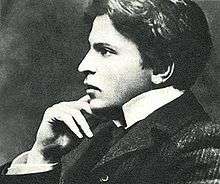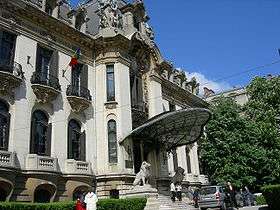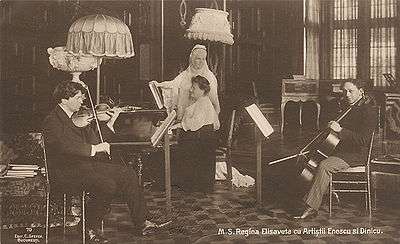George Enescu

George Enescu (Romanian pronunciation: [ˈd͡ʒe̯ord͡ʒe eˈnesku]; 19 August 1881 – 4 May 1955), known in France as Georges Enesco, was a Romanian composer, violinist, pianist, conductor, and teacher. He is regarded by many as Romania's most important musician.[1]
Biography

Enescu was born in Romania, in the village of Liveni (later renamed "George Enescu" in his honor), in Dorohoi County at the time, today Botoşani County. He showed musical talent from early in his childhood. A child prodigy, Enescu began experimenting with composing at an early age. Several, mostly very short pieces survive, all of them for violin and piano. The earliest work of significant length bears the title Pămînt românesc ("Romanian Land"), and is inscribed "opus for piano and violin by George Enescu, Romanian composer, aged five years and a quarter".[2] Shortly thereafter, his father presented him to the professor and composer Eduard Caudella. On 5 October 1888, at the age of seven, he became the youngest student ever admitted to the Vienna Conservatory,[3][4] where he studied with Joseph Hellmesberger Jr., Robert Fuchs, and Sigismund Bachrich. He was the second person ever admitted to this university by a dispensation of age (there was a regulation that stipulated that no person younger than 14 years could study at the Vienna Conservatory), after only Fritz Kreisler (in 1882, also at the age of seven), and the first non-Austrian.[5]
In 1891, the ten-year-old Enescu gave a private concert at the Court of Vienna, in the presence of Emperor Franz Joseph.[6]
Joseph Hellmesberger Sr., one of his teachers and the director of the Vienna Conservatory, hosted Enescu at his home, a place where the child prodigy met his idol, Johannes Brahms.[7]
He graduated before his 13th birthday, earning the silver medal. In his Viennese concerts young Enescu played works by Brahms, Sarasate and Mendelssohn. In 1895 he went to Paris to continue his studies. He studied violin with Martin Pierre Marsick, harmony with André Gedalge, and composition with Jules Massenet and Gabriel Fauré.
Enescu then studied from 1895 to 1899 at the Conservatoire de Paris. André Gedalge said that he was "the only one [among his students] who truly had ideas and spirit".
On 6 February 1898, at the age of only 16, George Enescu presented in Paris his first mature work, Poema Română, played by the Colonne Orchestra (at the time, one of the most prestigious in the world) and conducted by Édouard Colonne.[8]
Many of Enescu's works were influenced by Romanian folk music, his most popular compositions being the two Romanian Rhapsodies (1901–2), the opera Œdipe (1936), and the suites for orchestra. He also wrote five symphonies (two of them unfinished), a symphonic poem Vox maris, and much chamber music (three sonatas for violin and piano, two for cello and piano, a piano trio, two string quartets and two piano quartets, a wind decet (French, "dixtuor"), an octet for strings, a piano quintet, and a chamber symphony for twelve solo instruments). A young Ravi Shankar recalled in the 1960s how Enescu, who had developed a deep interest in Oriental music, rehearsed with Shankar's brother Uday Shankar and his musicians. Around the same time, Enescu took the young Yehudi Menuhin to the Colonial Exhibition in Paris, where he introduced him to the Gamelan Orchestra from Indonesia.[9]


On 8 January 1923 he made his American debut as a conductor in a concert given by the Philadelphia Orchestra at Carnegie Hall in New York City, and he subsequently made frequent returns to the United States. It was in America, in the 1920s, that Enescu was first persuaded to make recordings as a violinist. He also appeared as a conductor with many American orchestras, and in 1936 he was one of the candidates considered to replace Arturo Toscanini as permanent conductor of the New York Philharmonic.[10] In 1932, Enescu was elected a titular member of the Romanian Academy.[11] In 1935, he conducted the Orchestre Symphonique de Paris and Yehudi Menuhin (who had been his pupil for several years starting in 1927) in Mozart's Violin Concerto No. 3 in G major. He also conducted the New York Philharmonic between 1937 and 1938. In 1939 he married Maria Rosetti (known as the Princess Cantacuzino through her first husband Mihail Cantacuzino), a good friend of Queen Marie of Romania. While staying in Bucharest, Enescu lived in the Cantacuzino Palace on Calea Victoriei (now the George Enescu Museum, dedicated to his work).
He lived in Paris and in Romania, but after World War II and the Soviet occupation of Romania, he remained in Paris.
He was also a noted violin teacher. Yehudi Menuhin, Christian Ferras, Ivry Gitlis, Arthur Grumiaux, Serge Blanc, Ida Haendel, Uto Ughi and Joan Field were among his pupils. See: List of music students by teacher: C to F#George Enescu. He promoted contemporary Romanian music, playing works of Constantin Silvestri, Mihail Jora, Jonel Perlea and Marţian Negrea. Enescu considered Bach's Sonatas and Partitas for solo violin as the "Himalayas of violinists". An annotated version of this work brings together the indications of Enescu regarding sonority, phrasing, tempos, musicality, fingering and expression.[12]
On his death in 1955, George Enescu was interred in Père Lachaise Cemetery in Paris.
Today, Bucharest houses a museum in his memory; you can also visit his house in Dorohoi; likewise, the Symphony Orchestra of Bucharest and the George Enescu Festival—founded by his friend, musical advocate, and sometime collaborator, the conductor George Georgescu[13]—are named and held in his honor. Recently, Bacău International Airport was named George Enescu International Airport.[14]
Reception
Pablo Casals described Enescu as "the greatest musical phenomenon since Mozart"[15] and "one of the greatest geniuses of modern music".[16] Queen Marie of Romania wrote in her memoirs that "in George Enescu was real gold".[17] Yehudi Menuhin, Enescu's most famous pupil, once said about his teacher: "He will remain for me the absoluteness through which I judge others", and "Enescu gave me the light that has guided my entire existence."[18] He also considered Enescu "the most extraordinary human being, the greatest musician and the most formative influence" he had ever experienced.[19] Vincent d'Indy claimed that if Beethoven's works were destroyed, they could be all reconstructed from memory by George Enescu.[20] Alfred Cortot, one of the greatest pianists of all time, once said that Enescu, though primarily a violinist, had better piano technique than his own.[21][22]
Eugène Ysaÿe's Solo Violin Sonata No. 3 "Ballade" was dedicated to Enescu.
Works


Selected works
- For a complete list, see List of compositions by George Enescu.
Operas
- Œdipe, tragédie lyrique in four acts, libretto by Edmond Fleg, Op. 23 (1910–31)
Symphonies
- Symphony No. 1 in E-flat major, Op. 13 (1905)
- Symphony No. 2 in A major, Op. 17 (1912–14)
- Symphony No. 3 in C major, with chorus, Op. 21 (1916–18)
- Symphony No. 4 in E minor (1935; completed by Pascal Bentoiu in 1996)
- Symphony No. 5 in D major, with women's chorus and tenor solo (1941; completed by Pascal Bentoiu in 1995)
Other orchestral works
- Poème Roumain, symphonic suite for orchestra, Op. 1 (1897)
- Romanian Rhapsody No. 1 in A major, Op. 11 (1901)
- Romanian Rhapsody No. 2 in D major, Op. 11 (1901)
- Orchestral Suite No. 1 in C major, Op. 9 (1903)
- Orchestral Suite No. 2 in C major, Op. 20 (1915)
- Orchestral Suite No. 3 in D major Suite Villageoise, Op. 27 (1937–38)
Chamber works
String quartets
- String Quartet No. 1 in E♭ major, Op. 22, No. 1 (1920)
- String Quartet No. 2 in G major, Op. 22, No. 2 (1950–52)
Sonatas
- Violin Sonata No. 1 in D major, Op. 2 (1897)
- Violin Sonata No. 2 in F minor, Op. 6 (1899)
- Violin Sonata No. 3 in A minor dans le caractère populaire roumain, Op. 25 (1926)
- Cello Sonata No. 1 in F minor, Op. 26, No. 1 (1898)
- Cello Sonata No. 2 in C major, Op. 26, No. 2 (1935)
Other chamber works
- Octet for Strings in C major, Op. 7 (1900)
- Cantabile et Presto, for flute and piano (1904)
- Dixtuor in D major, for wind instruments, Op. 14 (1906)
- Concertstück, for viola and piano (1906)
- Légende, for trumpet and piano (1906)
- Piano Quartet No. 1 in D major, Op. 16 (1909)
- Impressions d'Enfance in D major, for violin and piano, Op. 28 (1940)
- Piano Quintet in A minor, Op. 29 (1940)
- Piano Quartet No. 2 in D minor, Op. 30 (1943–44)
- Chamber Symphony, for 12 instruments, Op. 33 (1954)
Piano music
- Piano Suite No. 1 in G minor, Dans le style ancien Op. 3 (1897)
- Piano Suite No. 2 in D major, Op. 10 (1901/1903)
- Piano Suite No. 3, Pieces impromptues Op. 18 (1913–16)
- Piano Sonata No. 1 in F♯ minor, op 24, No. 1 (1924)
- Piano Sonata No. 3 in D major, op 24, No. 3 (1933–35)
Songs
Three songs setting Lemaitre and Prudhomme Four songs setting Fernand Gregh In German: Various settings of Carmen Silva (Queen Elisabeth of Romania) In Romanian - 3 songs
- Trois Mélodies, Op. 4 (1898)
- Sept Chansons de Clement Marot, for tenor and piano, Op. 15 (1907–08)
- Trois Mélodies, Op. 19 (1916)
Media
 |
|
| Problems playing these files? See media help. | |
See also
- Category:Compositions by George Enescu
- George Enescu Philharmonic Orchestra
- List of 20th century classical composers
References
- ↑ "George Enescu- Albums, Pictures – Naxos Classical Music.". Retrieved 5 November 2014.
- ↑ Voicana 1971, 52; Malcolm 2001.
- ↑ "ICR Viena vine la Budapesta - ARADON". aradon.ro. Retrieved 2014-04-17.
- ↑ "Romanian Achievements and Records: Part 15 | Romania In Our Hearts". romaniainourhearts.wordpress.com. Retrieved 2014-04-17.
- ↑ Anon. "George Enescu, fața nevăzută a unui geniu" [George Enescu, the Unseen Face of a Genius], Historia Special, 2, no. 4 (September 2013): 55. ISSN 1582-7968.
- ↑ Anon. "George Enescu, fața nevăzută a unui geniu" [George Enescu, the Unseen Face of a Genius], Historia Special, 2, no. 4 (September 2013): 10. ISSN 1582-7968.
- ↑ Anon. "George Enescu, fața nevăzută a unui geniu" [George Enescu, the Unseen Face of a Genius], Historia Special. 2, no. 4 (September 2013): 9. ISSN 1582-7968.
- ↑ Anon. "George Enescu, fața nevăzută a unui geniu" [George Enescu, the Unseen Face of a Genius], Historia Special, 2, no. 4 (September 2013): 11. ISSN 1582-7968.
- ↑ Liner notes - Angel/EMI Lp 36418 (1966)
- ↑ Malcolm 2001.
- ↑ (in Romanian) Membrii Academiei Române din 1866 până în prezent at the Romanian Academy site
- ↑ "Sonatas and Partitas : Educational Edition". Retrieved 2015-06-15.
- ↑ Alain Chotil-Fani, "Un voyage dans la Roumanie musicale: George Georgescu", Souvenirs des Carpates blog site (6 December 2007, accessed 14 July 2014).
- ↑ Despre aeroport >> Bacau Airport
- ↑ "George ENESCU Part I: Enescu the composer Evan Dickerson - May 2005 MusicWeb-International". musicweb-international.com. Retrieved 2014-04-17.
- ↑ "EXCLUSIV VIDEO Documentar inedit despre George Enescu: "A fost cel mai măreţ fenomen muzical, de la Mozart încoace"". adevarul.ro. Retrieved 5 November 2014.
- ↑ Anon. "George Enescu, fața nevăzută a unui geniu" [George Enescu, the Unseen Face of a Genius], Historia Special, 2, no. 4 (September 2013): 14. ISSN 1582-7968.
- ↑ "Yehudi Menuhin, aproape rom�n | Muzeul National "George Enescu" - GeorgeEnescu.ro". georgeenescu.ro. Archived from the original on 2014-04-15. Retrieved 2014-04-17. replacement character in
|title=at position 28 (help) - ↑ "The Romanian Cultural Centre in London". Archived from the original on 18 May 2014. Retrieved 5 November 2014.
- ↑ "Radio Romania Muzical". en.romania-muzical.ro. Retrieved 2014-04-17.
- ↑ "Music: George Enescu — Gentle Giant | Crisis Magazine". crisismagazine.com. Retrieved 2014-04-17.
- ↑ "ENESCU piano music Vol 2 Borac AVIE AV2081 [GF]: Classical CD Reviews- March 2006 MusicWeb-International". musicweb-international.com. Retrieved 2014-04-17.
Sources
- Axente, Colette, and Ileana Ratiu. 1998. George Enescu: Biografie documentara, tineretea si afirmarea: 1901–1920. Bucharest: Editura muzicala a U.C.M.R.
- Bentoiu, Pascal. 2010. Masterworks of George Enescu: A Detailed Analysis, translated by Lory Wallfisch. Lanham, MD: Scarecrow Press. ISBN 978-0-8108-7665-1 (cloth) ISBN 978-0-8108-7690-3 (ebook). Translation of Capodopere enesciene. Bucharest: Editura muzicala a U.C.M.R., 1984.
- Brediceanu, M. et al. 1997. Celebrating George Enescu: A Symposium. Washington, D.C.:.
- Gheorghiu, V. 1944. Un Muzician Genial: George Enescu.
- Cophignon, Alain. 2006. Georges Enesco. Paris: Librairie Arthème Fayard. ISBN 978-2-213-62321-4. Romanian version as George Enescu, translated by Domnica Ilea, Bucharest: Editura Institutului Cultural Român, 2009, ISBN 978-973-577-578-0.
- Cosma, Viorel. 2000. George Enescu: A Tragic Life in Pictures. Bucharest: The Romanian Cultural Foundation Publishing House.
- Malcolm, Noel. 1990. George Enescu: His Life and Music, with a preface by Sir Yehudi Menuhin. London: Toccata Press. ISBN 0-907689-32-9 (cloth); ISBN 0-907689-33-7 (pbk)
- Malcolm, Noel. 2001. "Enescu, George." The New Grove Dictionary of Music and Musicians, second edition, edited by Stanley Sadie and John Tyrrell. London: Macmillan Publishers.
- Roth, Henry (1997). Violin Virtuosos: From Paganini to the 21st Century. Los Angeles, CA: California Classics Books. ISBN 1-879395-15-0
- Slonimsky, Nicolas (ed.). 2001. "Georges Enesco." Baker's Biographical Dictionary of Musicians. Centennial Edition. New York: Schirmer Books.
- Voicana, Mircea. 1971. “Anii de formare: Copilǎria (1881–1888); Studiila la Viena (1888–1894)”. In George Enescu: Monografie. 2 vols, edited by Mircea Voicana, 1: 7–129 (part 1, chapters 1–2). Bucharest: Editura Academiei Republicii Socialiste România.
- Voicana, Mircea (ed.) 1976. Enesciana, I. . (in Fr., Ger., and Eng.)
External links
| Wikimedia Commons has media related to George Enescu. |
- Works by or about George Enescu at Internet Archive
- Legendary Violinists
- International Enescu Society
- Georges Enesco's Profile at The Remington Site: his Continental Bach Recordings and Remington Recordings plus a survey of Sonatas & Partitas in the 1950s
- International Festival and Competition "George Enescu"
- Free scores by Enescu at the International Music Score Library Project (IMSLP)
- Free scores by George Enescu in the Choral Public Domain Library (ChoralWiki)
- A page on the closely linked lives of Enescu and Chailley
- Another site, with a helpful timeline
- Pascal Bentoiu: George Enescu, the composer
- Reissue of the complete Bach clavier concertos conducted by Enesco on 4 CDs
- Review on Musicweb-International by Evan Dickerson of available recordings featuring Enescu's compositions (updated May 2005)
- Review on Musicweb-International by Evan Dickerson of Enescu's recordings as a performer (violinist, conductor & pianist)(updated July 2005)
- Romanian Rhapsody No.1
- Georges Enescu Octet in C, Op.7 sound-bites and short bio